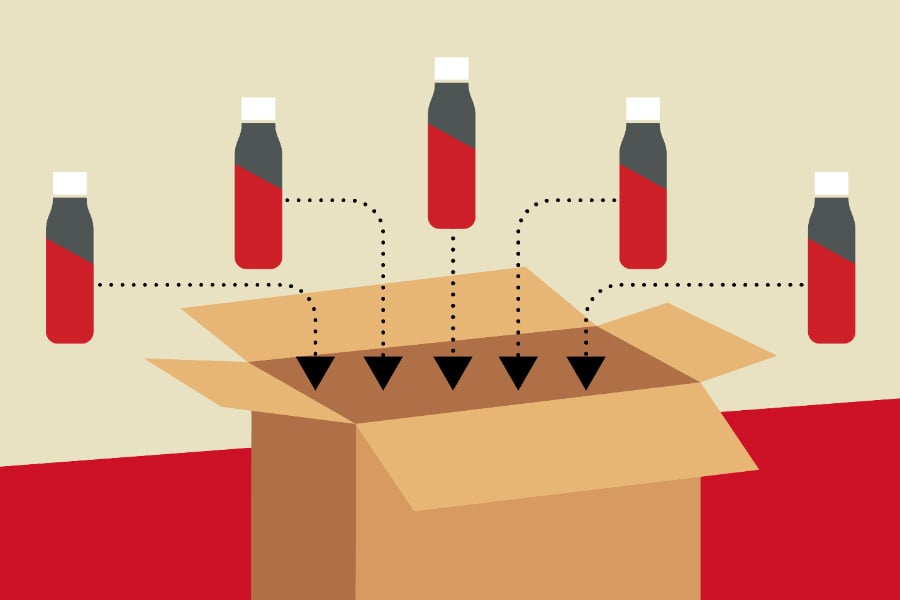Logistics
Warehousing & Fulfillment
Transportation
E-commerce
E-commerce Fulfillment Services
Lease & Maintenance
Semi Trucks
Supply Chain Technology
Logistics
E-commerce
Lease & Maintenance
Buy Used Trucks

An eagerly-awaited order arrives on your doorstep. You bring it inside, open the box, and find... something like this:

Having to dispose of so much unnecessary packaging is annoying for your customers. But it also has negative consequences for your brand. Why? Because using big shipping containers and lots of packing filler isn't just expensive - it also means more time wasted during the packing process and a slowdown in order processing.
How do you avoid scenarios like those above? By putting in place a robust cartonization strategy.
Cartonization is a part of the e-commerce order fulfillment process where a single item or group of items is assessed to determine the best way to pack orders for shipment. Key aspects of the cartonization process include:
Cartonization may be done manually by packing operators who are trained in cartonization rules for a specific SKU base, or via cartonization software belonging to a modern Warehouse Management System (WMS) or Enterprise Resource Planning (ERP) platform.
By finding the most effective method to pack orders for delivery, e-commerce merchants can achieve a range of positive business outcomes, including reducing shipping costs, reducing waste, and lower material and labor costs.
Single-item cartonization is when a specific SKU is matched to a certain container with matching dimensions for packing and shipping. This is designed for e-commerce orders which contain only one item, or a group of like products being packaged together.
Multi-item cartonization assists merchants with packing orders that contain multiple items of different dimensions and product characteristics, or wholesale orders that require. Cartonization is used to calculate the overall carton size needed to fit in all the items, or whether a split shipment may be more cost-effective.
Businesses selling specialist products or with very specific packaging requirements may choose to set their own cartonization rules. Cartonization software with advanced algorithms can be used to program custom rules for different SKUs or product types, providing packing operators with instructions on how to pack items correctly.
With the growing demand for free shipping and expedited options like same-day delivery, shipping costs can add up quickly for online retailers. The way you pack orders has a huge bearing on how much you need to pay for shipping - and could result in you leaving a lot of money on the table.
This is because all major carriers charge for shipping according to dimensional (DIM) weight; the larger and heavier items are, the more they cost to ship. The cartonization process ensures that smaller packages are shipped and extra space is eliminated, resulting in lower-cost shipping.
Time is of the essence if you're going to meet that coveted two-day shipping window. Orders need to be processed, picked, and packed in a highly efficient way - and there's little room for error.
Without your own cartonization rules for operators to follow, this results in a slower, more cumbersome packing process that's vulnerable to higher waste and a lack of quality control. If you're a high-volume operation, even minor delays can cause orders to pile up and miss those daily shipping cut-offs. Cartonization means that operators don't need to keep reinventing the wheel every time they pack an order, resulting in higher productivity.
Packaging materials are one of the most overlooked contributors to total fulfillment cost. Every cardboard box or piece of bubble wrap you use adds to your monthly packaging bill. If you aren't keeping track of what packaging is being used for what orders, you could easily end up spending far more than necessary.
For example, packing small, fragile items in large boxes requires using a large quantity of packing filler to cushion items in transit and prevent damage. These traditional manual shipping methods result in excess waste and cost. By using smaller containers, this extra cost can be avoided.
Cartonization is a powerful workflow and cost optimization strategy for e-commerce merchants. But there are other compelling reasons to embrace cartonization as the e-commerce marketplace matures and online shopping behaviors evolve.
The rise in single-item orders. As free shipping offers become more commonplace, consumers have less incentive to fill their shopping cart with additional items to justify the cost of shopping. Fulfilling orders with only one or two is less cost-effective for merchants than multi-item orders, so they must determine the best way to incur saving costs. A robust single-item cartonization strategy is essential to prevent merchants from making a loss on smaller orders.
The growth of omnichannel shopping services. Cartonization also extends to the growing popularity of services such as BOPIS and curbside pick-up. Orders being fulfilled in-store, shipped from the store, or sent from the warehouse to the store for pick-up all require advanced cartonization to keep fulfillment costs down.
Consumer concerns about packaging waste. Consumers are growing more conscious of the environmental impact of their purchasing habits, and this is resulting in more scrutiny of the packaging habits of e-commerce brands. Hashtags like #amazonpackagingfails have racked up thousands of views online, thanks to the e-commerce giant's casual attitude towards packaging waste. According to the Global Sustainability Study 2021, 60% of consumers say that sustainability is a key factor in choosing products and brands. Cartonization ensures that additional packaging material use is kept to a minimum, which means happy customers and a better reputation.
E-commerce marketplaces have strict packaging/labeling rules. As e-commerce giants like Amazon and Walmart transition from retailers to end-to-end fulfillment solutions, brands need to be aware of the cartonization requirements they must follow to sell or fulfill orders via these services. For example, Amazon FBA requires merchants to be packed and labeled according to specific dimensions, or they may incur an additional preparation fee. To avoid multiple orders from being stung by extra fees, your cartonization system should be set up to these specifications.
As turnaround times from order processing to shipping become faster and faster, searching for a Warehouse Management System with cartonization software included is essential to maintain fast delivery times and keep your distribution center running smoothly.
WMS capabilities such as real-time inventory management, order management, cycle counting, and intelligent shipping ensure a unified system to manage cartonization across channels.
Today, cartonization can be combined with powerful automation to streamline the packing process. Cartonization software can quickly capture key details about the items being packed to recommend the most cost-effective strategies for packaging material and shipping.
The Ryder platform offers a powerful rules-based automation system that enables brands to set custom packing rules for specific SKUs. For example, you can specify whether items are already packed within shippable containers, if products such as alcohol or hazmat items are present in an order, or whether a specific type of packaging is required. This speeds up the packing process and gives operators specific guidelines to manage cartonization effectively.
As your business scales and your order volumes rise, there is less room for errors and inefficiencies in the order fulfillment process. The use of additional packaging material or a too-large container every so often might not seem like something to sweat over. But at the macro level, this adds up to lost cost savings and excess waste that could be avoided with a better cartonization strategy. Cartonization:
Interested in how you can implement better cartonization software and strategies at your business? Contact us today to find out how Ryder can help to streamline your fulfillment process.